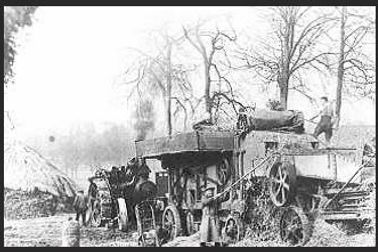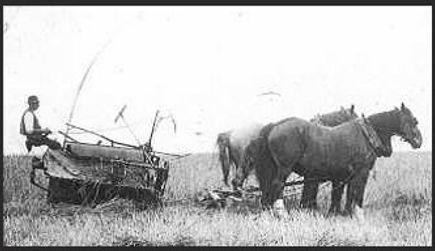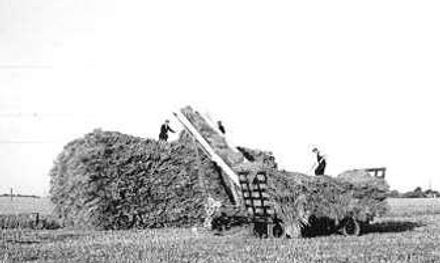top of page

FARMING

Shire horses

Bagging barley
BENSON'S FARMS BY JOHN ALDRIDGE
Most of Benson’s farm buildings were erected in the 18th century and geared to provide facilities and fodder to maintain Bensington’s important stagecoach posting activities. Until 1840, when the railway network offered quicker and more comfortable travel, Benson was a thriving village, offering travellers hospitality on their way to and from London and other destinations.
Large quantities of hay and grain were required to feed the 200 or so horses necessary to keep the 100 stagecoaches and private carriages supplied with changes on their way from Oxford to London and Birmingham to Newbury. Meat, flour, eggs and dairy produce was required for the passengers and their servants. The farms were also used for the breeding, breaking and training of horses to meet the replacement demand because the working life of a stage horse was only about three years.
The end of the posting era was very sudden and dramatic. The village lost its lifeblood and the only alternative was to concentrate on dairy and arable farming. Most farms remained mixed, and then they gradually faded away for one reason or another until today only Hale Farm remains, with Battle Farm solely arable.
Old farms which have been redeveloped include:
Franklin's College Farm, High Street,
Bennet’s Farm, Crown Lane,
The Cedars, Brook Street ,
West’s Dairy Farm, Castle Square,
Churchfield Dairy Farm, Oxford Road,
Paddock Farm, Brook Street,
Treadwell’s Farm, Brook Street,
Brook Farm, Brook Street,
Brookside Farm, Brook Street,
Mill Hill Farm,
Lower Farm, Preston Crowmarsh,
Fifield Farm
Most of the farm buildings have been demolished and the land sold for housing developments, to larger farming estates or absorbed into RAF Benson airfield. (See map at foot of page.)


Battle Farm, Preston Crowmarsh, 1960s
Cow and calf grazing at "Journey's End", Rokemarsh
Gone forever is the old type farm and farm yard proudly displaying its well-built ricks of hay and corn with free roaming chickens, ducks, geese, turkeys and piglets. Horses were kept in the home paddock or stable, always ready and eager to pull the plough, harrow or cart, with the home-bred herd of cows congregating by the field gate (as if they knew the time) waiting to enter the milking parlour. Here they were called by name to the allotted stall, where a generous ration of cereals with shredded mangolds and swedes awaited their consumption while they were sympathetically milked by hand. The buckets of warm milk were taken to the dairy where the milk was gravity fed through a filter over the corrugated cooler ready for daily collection by the nearest creamery. It was transported in 10 gallon churns or dispensed by pint and half pint ladles into jugs from house to house in the village.
The cart horses and driving ponies have now all gone except for the all too few enthusiasts who are happy to spend their cash to keep alive our traditional farming power and transportation. I feel privileged to have been born at a time that allowed me in my young days at Roke Farm to stable, feed, groom, harness and back a heavy cart horse into the shafts of a four wheeled wagon and trundle with a trace horse tied behind over the tracks to a distant field of golden corn. After a pause to slot in the rades at back and front to extend the carrying capacity we would weave through the sheaves (neatly stacked in stooks of eight to dry). Always aware of surveillance from the expert eye of Jack Herridge (lifelong carter and ploughman) under whose tuition we were taught to safely negotiate the narrow gateways and care for our charges.


Reaper and binder machine in action Threshing with a traction engine
With two-pronged pitchforks the wagon was loaded and carefully stacked, sheave butts outwards, to around five feet (1.75m) high. The trace-horse chains were hooked on the front of the shafts and with a quiet command the co-ordinated surge of double horse power and wagon moved slowly and majestically on its way back to the rickyard. We took our turn to pull in close to the elevator set to drop the sheaves over the centre of the rick which was positioned on a high spot so that rainwater drained away until threshing time arrived in the winter months.
The rick builder was a skilled man and proud of his ability to stack a rick 20ft diameter by 15ft high that would not bulge or collapse, with a good 45° pitch on top that would take a weather proofing thatch against the elements. The sheaves were placed with the butts to the outside and carefully interlocked. The sides sloped gently outwards to combat driving rains. When all was safely gathered in, the farmer and his men could relax a little and give thanks with a Harvest Home Celebration. Except for a few rats and mice that the farmyard cats have missed, the rick kept the grain and straw in good condition.
Stacking stooks on a haystack

When threshing time arrived, “Belsans” of Chalgrove or “Wilders” of Wallingford were booked for the appropriate days. Their steam traction engine arrived towing the threshing machine and elevator. They positioned ready for an early start the next morning. The boiler was lit at 6am and achieved full steam at about 7.30am. The driving lever was slowly pushed forward and with a ‘bark’ and ‘puff’ the heavy fly wheel began to move. The long crossed-over belt gently flapped and turned the machine. When the correct speed was reached, the throbbing and whining noise of the thresher, sieve and winnower began.
Another belt turned the elevator chain, to convey the grain-less straw to the centre of a new rick, which would be used for thatching or bedding. The driver had to deal with his engine’s constant demand for water and fuel. Sheaves were pitched the correct way round to the feeder person on top of the thresher, who cut the strings and guided the corn through the mouth. One man at the side of the machine hooked on the sacks to be filled with grain and sealed them with the same strings as tied the sheaves. A full sack of corn weighed 2.25 hundredweight (114kg). Another man removed the chaff which was discharged underneath, while two others were building the rick of straw. It was thirsty work with dust and pollen flying everywhere, so at l0am, 1pm and 4pm everything stopped for tea or beer.

Prepared by Colin English from the Ordnance Survey OS six-inch England and Wales Berkshire Sheet XVI 1883 Reproduced with the permission of the National Library of Scotland

Old Field Names around Benson, hand-written by Delia Chamberlain
THE SWING RIOTS IN BENSON
Click here to read an article about the unrest, which started in the village in 1830
To read a detailed account of the Swing riots in Benson see chapter 5 of
"Benson, a village through its history," by Kate Tiller
(available from the Bensington Society.)
bottom of page